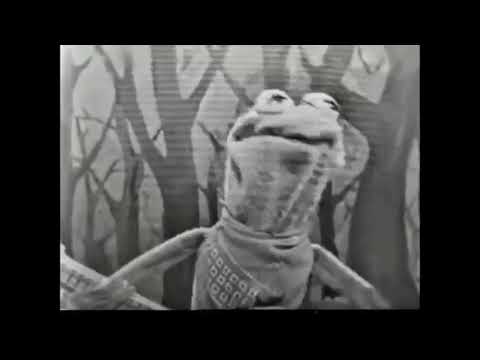Before the premieres of The Muppet Show in 1976 and Sesame Street in 1969 — and even before he was a frequent guest on The Ed Sullivan Show in the late 1960s — Jim Henson created a puppet show called Sam and Friends, which debuted 70 years ago today, on May 9, 1955. While the show’s episodes were just five minutes long, over the course of an 1,000-episode run, Sam and Friends became where Henson first figured out key parts of the Muppets’ now-familiar style and where at least one very familiar face would make his debut.
When he was still in high school, Henson got a job at the local Maryland television station WTOP on a new children’s show called The Junior Morning Show, where kids read the news alongside some puppets. Henson wanted to work in television, but he had no interest in reading the news, so he opted to build puppets for the show. Unfortunately, “the show lasted just three weeks before it was canceled,” explains Craig Shemin, author of the book Sam and Friends: The Story of Jim Henson’s First Television Show and the forthcoming The Sam and Friends Script Book.
Despite the short-lived nature of The Junior Morning Show, Henson and his puppets made an impression on the guy running the series, who referred Henson to a friend at the local NBC affiliate in Washington D.C., WRC. Henson then worked on a number of local shows for WRC, including Afternoon, which he began while still in college. Around the same time, he also met classmate Jane Nebel and invited her to work with him at WRC. She soon became a partner on Henson’s creative projects and would marry him in 1959.
Don’t Miss
“Jim and Jane were doing the Muppets on Afternoon. Then the station said to Jim, ‘We’ll give you your own five-minute show’ and that was Sam and Friends,” says Shemin. The show would air at the end of a block of news, weather and sports. “That’s the start of Jim’s own television show and the Henson Company considers 1955 as the start of the Jim Henson Company,” explains Shemin.
To get ready for the show, Henson carried over his puppets from Afternoon and built several new ones. Among them was Sam, a human puppet with a rigid papier-mâché head, and a flexible little green guy made from his mother’s old coat. He was named Kermit, although he wasn’t a frog yet — just one of the show’s many abstract characters. (It wouldn’t be until the late 1960s that he officially became an amphibian.)
Like The Muppet Show, Sam and Friends had both musical and comedy sketches, but done in a much more rudimentary way. For the first few years, “the Muppets would lip-sync to a comedy record from someone like Stan Freberg or to a popular song or even a standard novelty song. Jim would come up with a funny way to act it out or lip-sync to it. Most of the time, the sketch would end either with one character eating the other or blowing the other one up, which Jim continued on doing through the 1960s on variety shows,” says Shemin.
Shemin notes that some of the credit for the use of lip-synching can be attributed to children’s entertainer Bill Baird, who had been running a competing morning show on CBS during which puppets lip-synched to records.
And so, Henson did the same thing on The Junior Morning Show and then again on Afternoon and on Sam and Friends. “Jim really didn’t talk for the characters at first,” says Shemin. “All the characters just lip-synced. Then Jim started to do more talking for the characters when he was doing a series of commercials for Wilkins Coffee.”
When the characters did begin to speak, they did so in sketches about fairy tales and pop-culture parodies on subjects like Meet the Press and the film The Untouchables. Shemin notes there was even a sequence that would evolve into the recurring Muppet Show sketch “At the Dance.”

Sam and Friends’ on-air success also meant the show began attracting major sponsors, including the Esskay Meat company in 1958. That same year, Henson finally became more serious about puppetry. “In the beginning, this was just a college gig for Jim to make a little extra money. He was hoping to become an artist,” explains Shemin. “Then in 1958, he took a trip to the World’s Fair in Brussels. He went to Germany and Paris and he saw European puppeteers. There’s a long history of puppetry in Europe, and Jim started thinking that this was something he could work with and pursue past college.”
He came back from Europe a far-more focused man. He formalized the Jim Henson Company and told Jane they were getting married — even though they weren’t dating yet.
They married in 1959 and, two years later, Sam and Friends ended despite its popularity. “For years and years, the official story that Jim and Jane used to say was, ‘We just wanted to do other things.’ At the time, they had started doing a weekly remote on The Today Show in New York City. With that, they figured New York is really the next step for them because the television business was centered in New York at the time,” explains Shemin. “But, as I did more research, I actually found the letter they got from the ad agency canceling the show. Esskay decided not to sponsor the show anymore.”
Shemin says that Sam and Friends was likely still popular enough to find a new sponsor, but this represented a chance for the Hensons to move to New York and onto bigger prospects. It also set a precedent for Henson: He never stayed on any one project for too long. Even The Muppet Show ended after just five years.
In New York, Henson began appearing on various variety shows, including his first in the national spotlight, The Jimmy Dean Show, on which Rowlf the Dog became the regular sidekick of singer and actor Jimmy Dean. This soon led to regular appearances on the highly-rated Ed Sullivan Show. Then Sesame Street, then The Muppet Show and on and on.
Over time, the remaining puppets from Sam and Friends would fall away, save for one, who would be rebuilt and retooled until he officially became a frog. To this day, then, he serves as the last remaining link to Henson’s first TV show.
Content shared from www.cracked.com.

